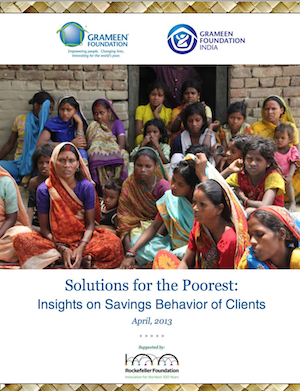10 Ways to Improve Savings Products for the Ultra-Poor
The following post was created from a new case study authored by Intellecap for Grameen Foundation India and edited by Kimberly Davies.
The poor need access to financial services to create diversified and reliable sources of livelihood, which help them move out of poverty. As an industry, microfinance, however, has found it difficult to reach the very poorest. The Livelihood Pathways for the Poorest project, which is jointly implemented in Gaya District, Bihar, India by the Grameen Foundation and the Livelihood School (part of BASIX group of companies), aimed to pilot a program that could fill the wide gap in services to the ultra-poor.
You can now read the findings of this project in our newest white paper, Solutions for the Poorest: Insights on Savings Behavior of Clients. This paper offers insights on savings behavior that are both layered and deep. We have classified these insights into three categories: program level, group level, and client level insights. Among those categories, here are the ten factors we discovered that had the greatest impact:
1. Flexible savings products motivate the poorest to save
The poorest have unreliable income sources, so product flexibility is critical. Voluntary savings products can make it possible for clients to save at their convenience without any restrictions. This flexibility, of savings amounts and intervals, removes the fear that comes with savings commitments, encourages attendance, and takes away potential embarrassment for members without savings contributions each week.
2. Flexibility of ASHG meeting schedules helps ensure attendance, and as a result, savings
The primary occupation of most households is wage labor and work schedules varied according to demand, which often change seasonally. The weekly Adapted Self-Help Group (ASHG) meetings were, therefore, scheduled to accommodate members and ensure maximum attendance. This approach to scheduling meetings has not only helped clients develop a sense of ownership and responsibility towards the ASHG, but also positively impacted savings.
3. Client trust and confidence in their ASHG, and implementing organization is imperative for savings mobilization
Many clients had previously invested time and energy into unfinished projects and schemes, leaving them without tangible benefits. Many households were therefore skeptical and needed to be convinced of project longevity. Exposure to successful ASHGs helped restore client confidence.
4. Clients save when they see tangible benefits
Clients needed to see tangible benefits at the start of the program to start saving. Inter-lending, or collecting group savings for internal loans, began within six months of savings mobilization and proved to be a useful tool to demonstrate these tangible benefits.
5. Members who join later save more to catch up with peers
Members who signed up for savings after others often saved a large amount to catch up with members who had a head start.
6. Reinforced messaging guides ultra-poor to goal-oriented savings
We realized that repetition of key messages and use of innovative media (e.g, presentations and audio-visuals) played an important role in reaching out to the clients and spreading the message about goal-oriented savings. Regular interactions and household visits also played an important role in reinforcing these messages.
7. For women to save, support from the larger community and buy-in from male members who control financial decisions is critical
We learned early on that, in the target households, women cannot save without the consent of their husbands. We engaged proactively with the men through counseling during home visits, organizing exposure visits, and explaining the benefits of the program in meetings with them.
8. Participatory decision making ensures regular savings and loan repayment
Early in the project, the ASHG facilitators introduced participatory decision making and monitoring of savings, inter-lending, and loan repayment. Such participatory processes have resulted in members realizing that they have control over their savings, and that regular savings in the ASHG helps in securing loans during times of need.
9. Migration is a reality, but it does not stop people from saving
It seems intuitive to say that when members migrate seasonally, they would not be able to save and their savings would lag behind compared to other group members. However, we observed that migrating members were in fact saving in advance for the months they would be absent from the village.
10. Planned and unplanned expenditures impact savings patterns, so products must be flexible
Savings were seldom uniform, and varied with seasons, festivals and, marriages in the community. About 68 percent households reported saving the most during the months of July and November, as they earn regular income during these months by working as agricultural laborers.
Kimberly Davies is a program officer on Grameen Foundation’s Financial Services team.

?Click HERE to download the full paper.
- Categories
- Uncategorized
